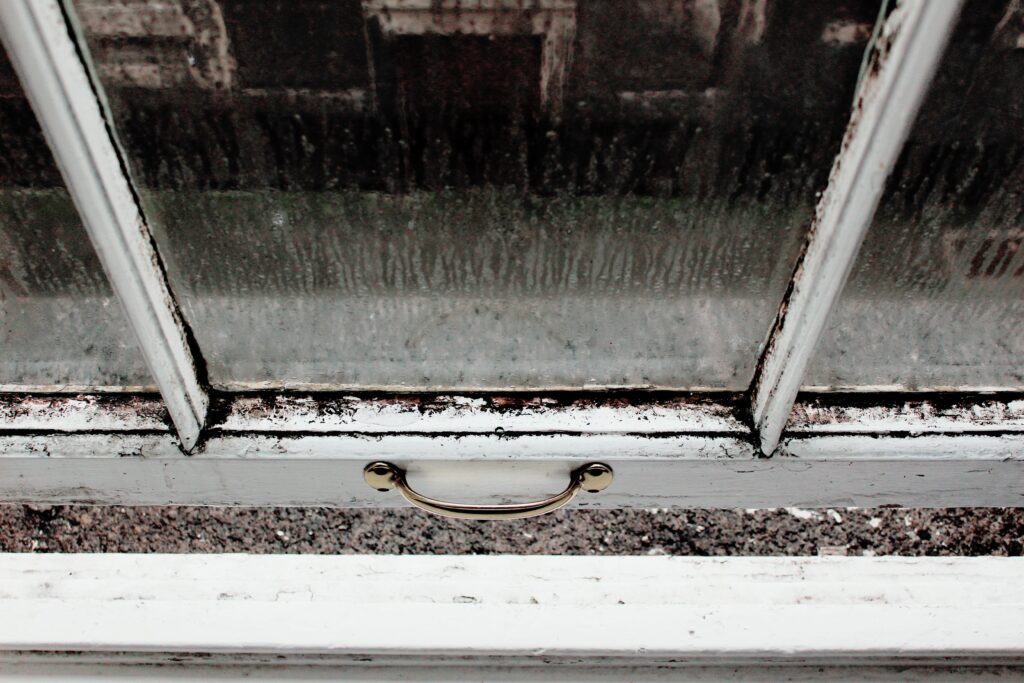Mould can be a problem in any home, but it’s especially common in winter. That’s because cold temperatures and high humidity create the perfect environment for mould to thrive. Mould around windows are one of the most common places for it to grow. So it’s important to take steps to prevent it. Read on to learn more about how this issue arises and some suggestions about managing it.
Cold, wet weather encourages the growth of many fungi including mould. While it can be found on walls and ceilings, mould also commonly grows on and around windows – and it can be difficult to get rid of.

Mould on and around windows can cause several problems in your home. Mould produces a musty and unpleasant smell. It also creates an unhealthy environment for all those who live in the home. Mould can damage the window frames and surrounding walls. Such damage can lead to water leakage and potential structural damage that could be expensive to repair. Left unchecked, mould can quickly grow to become a serious problem that requires professional attention.
Reasons why mould can form around your windows
Mould formation on and around windows in winter is a common problem. Therefore, it is important to understand what conditions are favourable for mould. This helps you to be proactive in managing and preventing it from becoming a big problem.
One of the biggest factors in winter is when warm air inside your home comes into contact with a cold window frame or wall around it . Often this is in an area with poor ventilation. This condensation provides a seedbed for mould spores. As these grow, they lead to the recognisable, black or green patches. In addition to windows fitting poorly or being warped/damaged, prolonged snow or rain can affect the sealing around a window. This will leave it prone to draughts which further encourages condensation and dampness and consequent mould growth. Wood, paint, wallpaper, dust, and dried leaves are amongst the food buffet that mould will feed on to fuel its growth.
While the window area is more vulnerable to these events during winter, they can also occur at other times of the year. Vigilance and addressing it should be part of your regular home maintenance. Higher temperatures and rainfall in warmer months also conspire to create ideal conditions around, and even on, windows for moulds to prosper.
Taking proactive steps can help to reduce the risk of mould forming in these areas. During winter months, and the rest of the year.
Causes of increased condensation on windows
Condensation on windows is an age-old problem, often exacerbated by modern living standards. A variety of factors can contribute to increased condensation. The most common is an increase in humidity levels, poor insulation, and drafts from openings in windows or walls. In an environment with high levels of moisture, it only takes a small drop in temperature for condensation to form.

Consequently, insufficiently insulated rooms are more likely to suffer from excessive dampness. Subsequent condensation results from rapid temperature changes and temperature differences between the inside and outside.
Also, inadequate ventilation can lead to trapped humidity inside the room which then condenses onto nearby surfaces like window panes.
So, there are three core elements at work here – humidity levels, insulation, and ventilation. Any one of them is capable of impacting the rate of condensation build-up on windows in the home or workplace. And the occurence of condensation increases when they work together.
Prevent mould around windows
To prevent mould and mildew growth on windows, it’s important to regulate moisture levels in the room. During winter months, when humidity is especially high due to lower temperatures, this is even more critical.
Monitor this vulnerable area
- Regularly scan windows and frames to detect any signs of mould. Look for dark spots or discolouration on the surface or around the edges of windows. These could indicate the presence of mould. Pay close attention to areas near air vents, in corners, and in other places where moisture can accumulate. Take appropriate action if any visible signs of mould are detected. Make sure to inspect your windows and frames regularly to prevent mould from growing.
- Mould on the outside of windows, frames and window sills can also pose a risk to those living indoors. The spores travel through the open windows to cause allergy symptoms, asthma attacks and other respiratory issues. This is can especially impact those who are sensitive to mould or who already have breathing problems. So, make sure that any mould growing on the outside of windows is also promptly removed. And keep the surrounding area dry. Consider air filters in these areas to catch any mould spores before they can get set up in your home.
Reduce risk
- Ideally, make sure that the windows are well-fitted and limit draughts. A well-fitted window will provide an airtight seal. This limits condensation from forming, so limiting the ideal conditions for mould growth.
- Airflow should be optimised so that air can circulate around the window. This dries out condensation that might collect from humid air inside. To achieve this, open shades and curtains when possible and opt for breathable materials like cotton.
- Keeping the area around windows dry is essential to help limit mould growth. Make sure to regularly remove any water droplets or condensation. Try to avoid placing furniture, plants, or other items too near the windows that may trap moisture. Installing fans near windows can also help circulate air, keeping them dry and making it less likely for mould to grow. Ensuring adequate ventilation in rooms with windows and closing curtains when not in use can also help keep moisture away from the window frames.
Clean and remove

- Regularly cleaning the windows and frames with a solution of vinegar and warm water will help keep mould at bay. Built-up dirt or debris can contribute to its growth as it will feed on this. For tough stains, scrubbing with an old toothbrush may be necessary. All surfaces must be thoroughly dried using paper towels or a hairdryer afterwards.
- If a significant number of black spots appear on or near windows, however, it may be time to call a professional. Mould removal can be tricky and time-consuming.
Mould can form on and around your windows, especially in winter, due to the high humidity levels and temperature contrasts indoors and outdoors. By taking some simple measures, you can help reduce the risk of excessive mould growth in your home this winter, and ensure the longevity of your windows too!